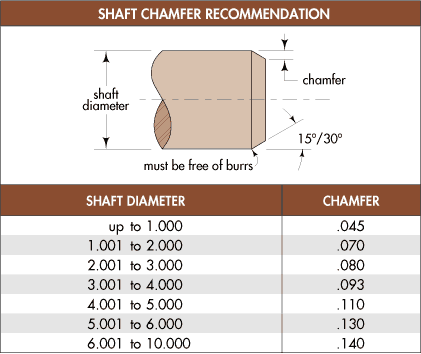|
|

  |
 |
 |
 SHAFT REQUIREMENTS SHAFT REQUIREMENTS
Four factors concerning the shaft must be considered:
material hardness, chamfer, surface finish, and tolerance.
 SHAFT HARDNESS SHAFT HARDNESS
For best results, the shaft should be of a medium carbon steel, SAE 1035-1045.
Stainless steel and hard-plated surfaces such as chrome or nickel plate also work
well. Minimum hardness should be Rockwell C30. Shafts of soft materials such as
brass, bronze, aluminum alloys, or zinc are not recommended.
 SHAFT CHAMFER SHAFT CHAMFER
A lead-in angle on the shaft ensures against damage occuring while the seal is
being installed. The diagram below shows recommended shaft chamfer.

 SHAFT TOLERANCE SHAFT TOLERANCE
Shaft tolerances for different shaft sizes are listed in the table below. Other design
considerations often require tighter tolerances (such as bearing-fit tolerances) than
those shown below.

 SHAFT SURFACE FINISH SHAFT SURFACE FINISH
Surface finish greatly affects the degree of wear on the seal lip. deVries International
recommends a surface finish of 10 to 20 Ra measured along the axis of the shaft. We
also recommend that this finish be created by plunge grinding the surface. This will
prevent a machine lead on the shaft which would accelerate lip wear and possibly
pump fluid under the seal lip.

|
|
|
|






